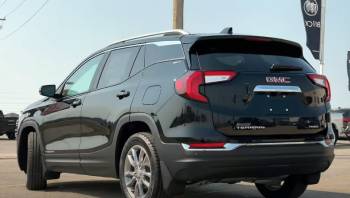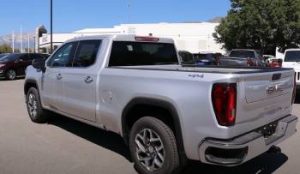When we talk about powerful, roomy, and stylish SUVs in the market, two prominent names come to the forefront: GMC Terrain and Chevy Traverse. Though both hail from General Motors, they have distinct features and quirks that make each unique.
Ready for the face-off? Let’s dive in!
A Brief Comparison Table
| Feature | GMC Terrain | Chevy Traverse |
| Segment | Compact SUV | Midsize SUV |
| Seating Capacity | Up to 5 | Up to 8 |
| Engine | Smaller engine (varies by year) | V6 Engine |
| Cargo Space | Limited | Generous |
| Fuel Efficiency | Better (Given the smaller engine) | Lesser than Terrain |
| Price Point | Generally Lower | Generally Higher |
| Interior Space | Compact | Spacious |
| Maneuverability | Better in tight spaces | Requires more space |
GMC Terrain: The Pros

- Compact Size & Design
The Terrain’s compactness works to its advantage, making it a favorite for city dwellers. It’s easier to maneuver, especially in tight parking spots, without compromising too much on interior space.
- Fuel Efficiency
Given its size, the Terrain is commendable when it comes to fuel economy. It’s gentle on the wallet and the environment!
- Premium Feel
The Terrain offers a plush interior with top-of-the-line features. Think of it as luxury at an affordable price.
GMC Terrain: The Cons
- Smaller Cabin Size
Being a compact SUV, the Terrain’s cabin might feel a tad crunched, especially when loaded with passengers and cargo.
- Less Towing Capacity
The Terrain might not be the best choice if you’re into heavy towing activities like hauling boats or trailers.
Also Read: Differences Between Diesel Pro And Stealth Modules.
Chevy Traverse: The Pros

- Spacious Interior
The Traverse is more expansive and can comfortably accommodate up to 8 people. Ideal for larger families or those weekend trips with the gang.
- Impressive Cargo Space
Pack in everything! The Traverse boasts a generous cargo area, perfect for those camping trips or hefty shopping days.
- Powerful Performance
With a potent V6 under its hood, the Traverse doesn’t shy away from tough terrains and long drives.
Chevy Traverse: The Cons
- Not-so-great Fuel Economy
Being a larger vehicle, the Traverse isn’t the best when it comes to miles per gallon. It’s more of a trade-off for the extra space and power.
- Bigger Footprint
In congested areas, the Traverse might be a bit of a handful due to its larger size.
Key Differences Between GMC Terrain and Chevy Traverse
Two dominant figures in the SUV sector, GMC Terrain and Chevy Traverse, both cater to different market segments within the SUV category. While both vehicles come from the General Motors family, they have a slew of contrasts in design, performance, space, and functionality. Let’s break down these differences:
- Size and Segment
- GMC Terrain: Falling under the compact SUV category, the Terrain has been designed to target users who want a mix of performance and compactness. Ideal for urban landscapes, it’s more compact and suitable for navigating tighter streets and parking spaces.
- Chevy Traverse: This is a midsize SUV. It’s considerably larger, providing more cabin space, and is designed for families and users who require more cargo space and seating capacity. This added size does mean it’s a bit more challenging to maneuver in densely packed cityscapes.
- Seating Capacity and Interior Space
- GMC Terrain: With its compact structure, the Terrain provides seating for up to 5 passengers. The interiors, while plush and comfortable, might feel a bit limited if you’re planning a road trip with a full house.
- Chevy Traverse: Catering to larger families, the Traverse comfortably houses up to 8 passengers. This makes it a prime choice for big families or those frequent road trips with friends.
- Engine and Performance
- GMC Terrain: The Terrain comes with a smaller engine when compared to the Traverse. However, this smaller engine means better fuel efficiency, especially in city conditions.
- Chevy Traverse: The Traverse boasts a more robust V6 engine, ensuring a powerful drive. If you’re looking for raw power and the ability to traverse various terrains easily (pun intended), the Traverse might be more up your alley.
- Cargo Space
- GMC Terrain: Given its compact nature, the Terrain offers limited cargo space. It’s perfect for day-to-day activities but could be a squeeze if you’re looking at extended travels or heavy-duty shopping.
- Chevy Traverse: The Traverse, with its larger size, offers impressive cargo space. Whether it’s a camping trip or moving day, the Traverse ensures you don’t leave anything behind.
- Fuel Efficiency
- GMC Terrain: Smaller engines generally translate to better fuel efficiency, and the Terrain is no exception. For city dwellers or those conscious about fuel economy, the Terrain might be more appealing.
- Chevy Traverse: As expected with larger, more powerful vehicles, the Traverse consumes more fuel. But what it might lose in fuel economy, it more than makes up for in space and performance.
- Price Point
- GMC Terrain: Generally, the Terrain comes at a lower starting price point than the Traverse, making it more accessible for those on a budget but still wanting an SUV experience.
- Chevy Traverse: The Traverse, given its size and features, is priced higher. However, for the space and power it offers, many find it a worthy investment.
Also Read: Differences Between Import Direct And Duralast Brake Pads.
FAQ Section:
Yes, the Chevy Traverse is significantly larger than the GMC Terrain. The Traverse is a mid-size SUV, while the Terrain is more on the compact side.
The GMC equivalent to the Chevy Traverse is the GMC Acadia. However, it’s crucial to note that while they are similar, they each have their nuances and unique offerings.
This depends on personal preferences. Both SUVs have their strengths. If size and cargo space are primary concerns, Traverse might be the go-to. However, if you’re looking for something slightly more compact with a touch of luxury, the Acadia might tick the boxes.
Many SUVs are larger than the GMC Terrain, given it’s a compact SUV. In the General Motors lineup, the Chevy Traverse, GMC Acadia, and Chevy Tahoe are just a few examples that are bigger.
The Chevy Traverse is an SUV, not a truck.
The Chevy Traverse is categorized as an SUV. While it offers ample space, similar to a van, it retains the design, performance, and functionality typical of SUVs.
Conclusion:
The decision between GMC Terrain and Chevy Traverse really boils down to individual needs. If you want something more nimble with better fuel efficiency, the Terrain might be your best bet. However, if space, power, and seating capacity are higher on your list, the Traverse takes the cake. Both vehicles offer reliability and style, ensuring that whichever you choose, you’re in for a treat.
Whether you’re team GMC Terrain or Chevy Traverse, there’s no denying that both these SUVs pack a punch in their domains. It boils down to individual requirements and tastes. Need something compact and efficient? The Terrain might just be your ride. Need space for everything and then some? Say hello to the Traverse. Happy driving!



